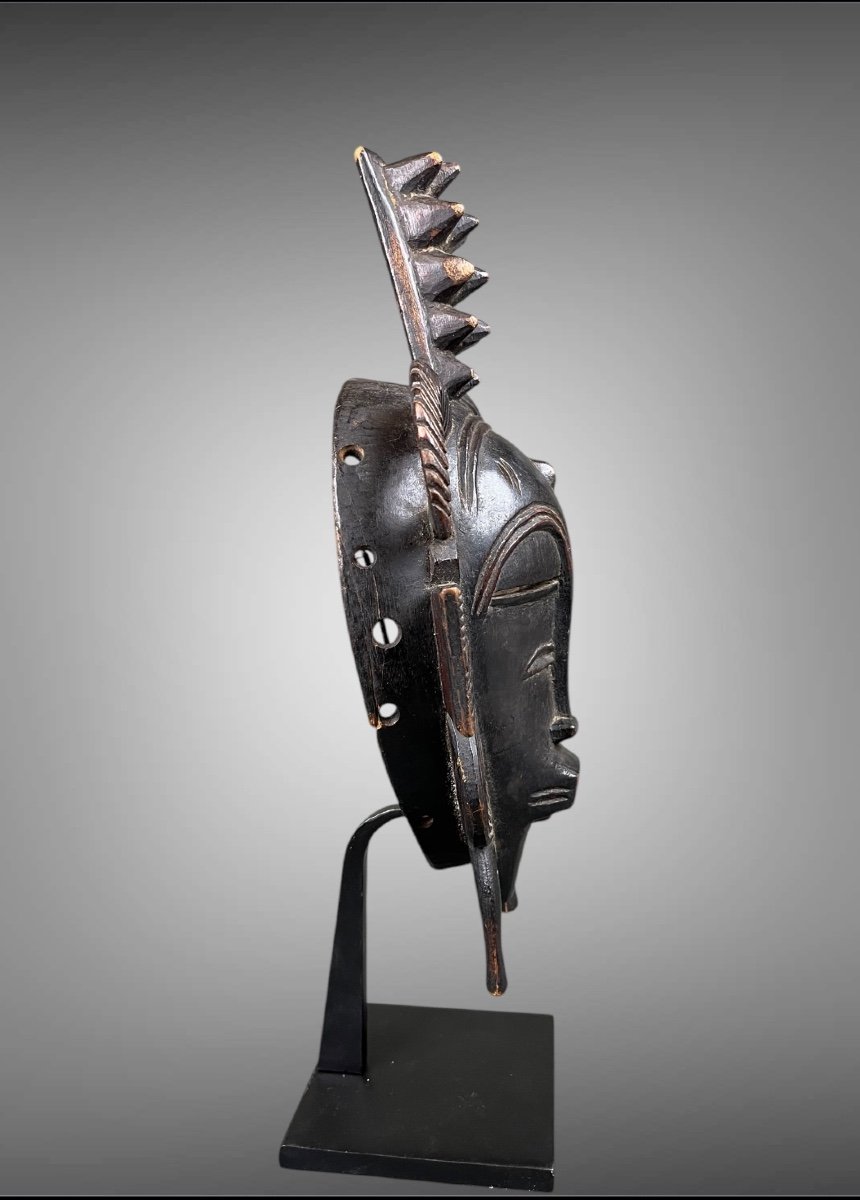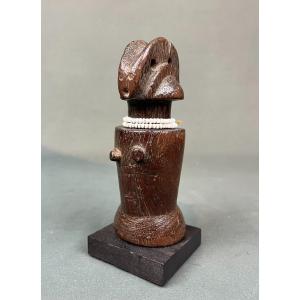elegant mask which dates from the 40s/50s
nice patina the right side has a crack viewed from inside i dont know if it has been reglued
provenance
private collection France
The kpelie mask is the best known and most famous mask of the Senufo culture. The original word is "kpeli yehe". The translation of these words are not clarified. In some books you can read "face of an acrobat, dancer or comedien", speaking with the carvers, their translation is "face of wood". The Kpelié always represents a male spirit, there are no female Kpelié masks.
The Kpelié can be carved by the occupational group of koule in wood and by the occupational group of Fono in wood or in metal, like bronze, bras or, after 1950, in aluminium. A daleguee is a Koulé carver, who is called by the tugubele spirits to carve the Kpelié. No matter casted in metal or carved in wood, the Kpelié serves different purposes. Every village does keep a number of Kpelié masks, wrapped in tissues, in the "Case sacrée", a house/shrine, for ritual trade. Every seven years the diviner asks the Tugubele spirits about the power of the masks. Some receive treatment with colour to gain more power, other masks are getting sold, when they have no power anymore. These masks get replaced by new masks made by the local carver or blacksmither. It is possible that masks come from other regions, but never from a different of the 30 sub-Groups of the Senufo. So the Kpelié is not a rare mask. There were and are large quantities needed in ritual usage and even more are produced as Airport-art articles.
All Kpelié masks show the follwing characteristic features, some vary because of the skills and abilities of the carvers , by the region and time of creation. There are pure masks with all typicial elements and masks overloaded with decoration features, which is the very own interpretation of a carver. There is a competing situation between the carvers, the one with a beautiful and impressive mask will receive respect and reputation, and will have more orders. Althought there were Christian and Islamic influences (the invation of the Massa cult after 1950) in Senufo life, the Kpelié style didn't change dramaticly since about 150 years. Till today, the Kpelié is danced in ceremonies.
Most remarkable is the elongated face with the half closed eyes, half-circle eyebrows and a long t-shaped nose. In the region west of Korhogo the mouth is rectangular shaped, filled with a right-angular hatching. The Senufo don't wear lip-pegs today, it is said, that their ancestors were wearing lip-pegs. So the mouth of a Kpelié always has an underlip peg. Beside the nose there can three or five furrows that represent facial scars. Every Kpelié has an oval shaped stigma on the front. This mark was caused by the calao bird, when he gave power and knowledge to the spirit by picking with his bill on the forehead. On some masks this scenery is illustrated at center top, featuring an abstract bird or a head with a very long hornbill. Talking about center top there is a huge variety on symbols, that represent certain attributes of the Senufo: The capok fruit, which is used by the koule only, because it is a symbol of their occupational group. T Recent masks, made after 1950 can display the chameleon. Older masks can have a geometric symbol or, in the region of Bolopé, a wing shaped object as center top.
The side decorations can vary in geometric forms from circular, rectangular, triangular or fantasy shaped. Sometimes they are plain without any pattern. But there can be masks overloaded with all kind of design that are possible to carve. Beside the center top attributes, there can be horns from a cattle or buffalo carved upturned or pointing downwards. Beneath the mouth there are so-called "leg pairs" in different shapes carved on every Kpelié mask. are developed from certain hairstyles, bunches on the side of the head, of the Senufo women.cf (markus ehrhard the art of the senufo culturej une 2017)About us - Welcome to the art of Senufo culture (senufo-art.com)


















































 Le Magazine de PROANTIC
Le Magazine de PROANTIC TRÉSORS Magazine
TRÉSORS Magazine Rivista Artiquariato
Rivista Artiquariato